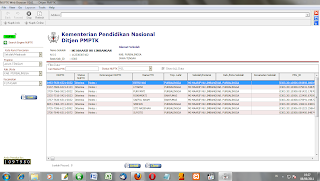NUPTK Blog
All of your NUPTK is here. (NUPTK = Nomor Unik Pendidik dan Tenaga Kependidikan)
Wednesday, June 8, 2011
NUPTK BA Aisyiyah Meri
The concept of grouping students together in a centralized location for learning has existed since Classical antiquity. Formal schools have existed at least since ancient Greece (see Academy), ancient Rome (see Education in Ancient Rome) ancient India (see Gurukul), and ancient China (see History of education in China). The Byzantine Empire had an established schooling system beginning at the primary level. According to Traditions and Encounters, the founding of the primary education system began in 425 A.D. and "... military personnel usually had at least a primary education ...". The sometimes efficient and often large government of the Empire meant that educated citizens were a must. Although Byzantium lost much of the grandeur of Roman culture and extravagance in the process of surviving, the Empire emphasized efficiency in its war manuals. The Byzantine education system continued until the empire's collapse in 1453 AD.[1]
Schools and Students
A school is an institution designed for the teaching of students (or "pupils") under the supervision of teachers. Most countries have systems of formal education, which is commonly compulsory. In these systems, students progress through a series of schools. The names for these schools vary by country (discussed in the Regional section below), but generally include primary school for young children and secondary school for teenagers who have completed primary education. An institution where higher education is taught, is commonly called a university college or university.
In addition to these core schools, students in a given country may also attend schools before and after primary and secondary education. Kindergarten or pre-school provide some schooling to very young children (typically ages 3–5). University, vocational school, college or seminary may be available after secondary school. A school may also be dedicated to one particular field, such as a school of economics or a school of dance. Alternative schools may provide nontraditional curriculum and methods.
There are also non-government schools, called private schools. Private schools may be for children with special needs when the government does not supply for them; religious, such as Christian schools, hawzas, yeshivas, and others; or schools that have a higher standard of education or seek to foster other personal achievements. Schools for adults include institutions of corporate training, Military education and training and business schools.
In homeschooling and online schools, teaching and learning take place outside of a traditional school building.
Looking for NUPTK ?
Here NUPTK for you .........
Click on the picture and copy. Paste to MS Word and print.
That is NUPTK for MI Muhammadiyah Limbangan today : Wednesday, June 8th, 2011.
But, only 7 names on there. I'm so sorry. This is real.
If the data were completed, we will upload its.
For another teachers and another schools, please send messages to us in comments coloumn below.
But, the replies was not directly for a day.
For, replies directly for a day, send a messages to us from your handphone to our number handphone.
This is our number handphone : 085291342915
Click on the picture and copy. Paste to MS Word and print.
That is NUPTK for MI Muhammadiyah Limbangan today : Wednesday, June 8th, 2011.
But, only 7 names on there. I'm so sorry. This is real.
If the data were completed, we will upload its.
For another teachers and another schools, please send messages to us in comments coloumn below.
But, the replies was not directly for a day.
For, replies directly for a day, send a messages to us from your handphone to our number handphone.
This is our number handphone : 085291342915
Subscribe to:
Comments (Atom)






























